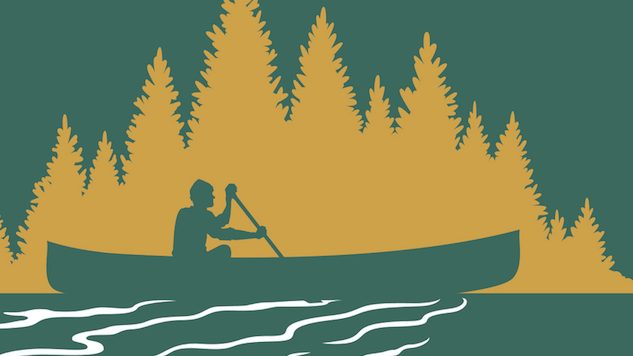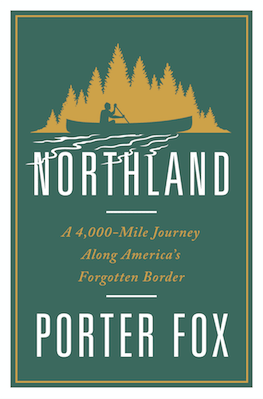Growing Up in Porter Fox’s Northland, the Forgotten Space of the U.S.-Canada Border
Books Features porter fox
With all eyes locked on our southern border, Porter Fox focuses on traversing the northern in his new book. Northland chronicles his 4,000-mile journey along the world’s longest international boundary: the U.S.-Canada border. Porous and raw, this invisible line is foundational to the history of our nation…and is now practically forgotten.
Like Porter Fox, I grew up in the Northland, a semi-permeable place along the American-Canadian border. Unlike Fox, I came of age in Western New York, the eastern chambers of the Northland’s industrial heart, in the softly waning glow of Rochester’s leading light of innovation—a distant Kodak flash; the sweeping green survey of a Xerox machine—and then, later, in the shadows of Buffalo’s industrial might along the Niagara River. It’s a place of constant wind, of falling water and snow, where the influences of three great nations can be found.
 Canada was a chimerical place to me, sitting across a lavishly demarcated border—it’s an underrated sight, snaking along the 190 at night, the city of Buffalo on one side and an entire nation on the other—whose influence was softly exerted in the Labatt Blue bottles in your fridge or in finding a coin from the North bearing the portrait of the Queen in your change.
Canada was a chimerical place to me, sitting across a lavishly demarcated border—it’s an underrated sight, snaking along the 190 at night, the city of Buffalo on one side and an entire nation on the other—whose influence was softly exerted in the Labatt Blue bottles in your fridge or in finding a coin from the North bearing the portrait of the Queen in your change.
Equally influential, as one draws closer to Buffalo, are the nations of the Haudenosaunee, or Iroquois. Children in Western New York are born with a lacrosse stick in their hand, and Iroquois imagery—with varying levels of deference and tone-deafness—mark the region’s connection to their game. Unlike most parts of the United States, Native Americans are not invisible in the Northland; signs advertising cheap gas and cigarettes along I-90—sometimes blocked off by protestors when I was a child for reasons I never knew—are joined by signs showing solidarity with Standing Rock.
My northland is pulled taunt as it heads west to Pennsylvania and Ohio, the rolling hills of Central New York still undulating in Rochester before becoming the flat line which spans from Buffalo to Chicago and beyond. It’s constantly green and grey in my mind—a place where the sun rarely shines—or else white and orange, a brilliant snowfield hemmed in on all sides by snow fencing.
That snow is perhaps our most famous aspect, beyond nuclear orange wings and losing Super Bowls, and few acts of nature are as delightful and frightening as a lake effect snow. It is soft, wet and thick, falling in sheets rather than flurries and accumulating with a dramatic speed. It crushes buildings and unleashes monsters, enormous bladed beasts preceded by flickering fire on their heads, to carve out canyons we would traverse on the way to the school bus. This journey would happen no matter how much snow fell; the joke, as parents prepared us for three feet of snow outside, was that the Second Coming would not stop school in Western New York.
Snow is a lake’s most obvious extension of power—revenge for the millions of keels which have cut across its face and the endless bodies and toxins which now lie along its bed. But more than anything, I recall spending what precious few “nice” days we had along the shores of Lake Ontario. I would venture along the concrete pier in the park, towards a piling of rocks at the end, in what felt like the middle of the sea. As cold waves licked the stones, I would jump between them, rocks and weeds and dead fish rising and falling between the crevasses. I’d feel like a fighting spark in the face of immeasurable and ancient power, an insect in the hand of a god, across the blue expanse an entirely different country.
The liminal land in between two titans is a place in and of itself. In a time when no borders should be ignored—when ICE and ice are indifferent to human lives—a travelogue like Fox’s, freighted with history and hope, blood and bone and snow, is all the more important.
B. David Zarley is a freelance journalist, essayist and book/art critic based in Chicago. A former book critic for The Myrtle Beach Sun News, he is a contributing reporter to A Beautiful Perspective and has been seen in The Atlantic, Hazlitt, Jezebel, Chicago, Sports Illustrated, VICE Sports, Creators, Sports on Earth and New American Paintings. You can find him on Twitter or at his website.